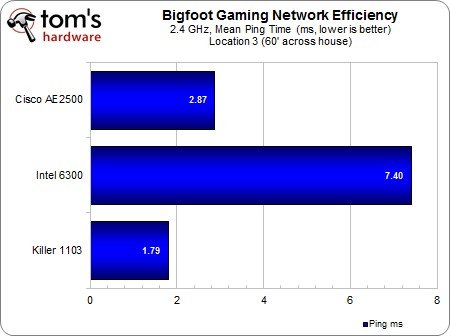Killer Wireless-N 1103 Review: Can Qualcomm Take On Centrino?
Benchmark Results: GaNE, 2.4 GHz
Qualcomm's Killer Gaming Network Efficiency benchmark is likely the test that gamers will pore over, as it delves into wireless ping times and jitter. Thus, we’ll emphasize including the raw charts here. The tool works by linking two wireless clients and running data between them. Because of the nature of the configuration, one client would need to stay present to help test the other two and act as a baseline. We selected the Killer 1103 system for this, and as a result we obtained two sets of GaNE Killer data for every one of the Cisco or Intel. In the following results, we averaged the two Killer numbers. Note that for each test, GaNE collected 300 ping data points for each system.
Is it surprising that our first results show Qualcomm handily trouncing the competition with their own benchmarking tool? Probably not. We all expect Qualcomm to win the day on ping times. However, it’s intriguing that the company is able to do this largely through its drivers, since the 1103 adapter itself centers on a standard radio in the company's portfolio, completely lacking the offload capabilities found on its accelerated desktop cards. Clearly, there’s more than hot air to Qualcomm’s claims of having proprietary intellectual property in play here.
Would anyone have guessed that Cisco’s USB adapter would yield lower latency results than Intel’s 6300 flagship? We should would have predicted the opposite. Also observe that there seems to be very little correlation between ping time and distance.
In these GaNE graphs, the Killer 1103 is the red line in all cases. On the left, black shows Cisco and on the right Intel. Do you see that weird spike in latency in the Location 1 Intel results? We were seeing those all the time from Qualcomm before our driver update. That’s how we know that much of the 1103’s performance advantage here is coming from software.
One advantage these graphics provide is that they allow us to see how two adapters are performing in the same time and environment. Any ambient interference affecting one should be affecting the other as both operate within two feet of each other across all locations. At the very least, it seems that Qualcomm is somehow filtering out system overhead or packet transfer limitations that Cisco and Intel are still battling.
Get Tom's Hardware's best news and in-depth reviews, straight to your inbox.
Current page: Benchmark Results: GaNE, 2.4 GHz
Prev Page Benchmark Results: PerformanceTest, 5.0 GHz Next Page Benchmark Results: GaNE, 5.0 GHz-
phamhlam I wish they would build better PCI-Express WiFi Adapter. Some of us can't have a cable going through our house or have our computer sit next to the router.Reply -
KelvinTy I think if you have the lowest latency at your end and leave everything on the server and internet end. Then it would be a lot better, especially there is input lag from everything, monitor, mouse, keyboard, wireless card, router and internet...Reply -
reghir There are 2 versions of the E4200 did you use version 1 or 2 as version 2 increases to 450Mbps on both bands and full spatial on its 3X3 streams?Reply -
MKBL I hope TH will review on powerline Ethernet adapter against typical RJ45 and wifi. For the same reason as phalmhlam, my desktop is connected to router by a long cable running across floor, which bothers me and my family sometimes. I've been considering powerline ethernet, but I can't make decision between that and wireless-N, because I have no idea which one has better performance/price.Reply -
CaedenV Great article! I learned quite a few things from it.Reply
I still think I will be waiting for 802.11ac before upgrading from G though. -
jaylimo84 M. Van Winkle,Reply
Thanks for this nice article.
I own an Alienware M17xR3, with the Killer 1103.
Upon installation, the driver was causing me issues (nothing big tho), and I decided to follow a forum recommendation and install the Atheros Osprey driver instead of Killer's.
It seems the two card are identical apart from the name on it. (Maybe I am misleaded)
It could be interesting to see if the Killer 1103 gets any improvement using the Killer driver vs. the vanilla Atheros drivers, and see if "years of working with the windows tcp stack" pays off. Or if your performance improvement is due to a good, but still normal card. -
CaedenV MKBLI hope TH will review on powerline Ethernet adapter against typical RJ45 and wifi. For the same reason as phalmhlam, my desktop is connected to router by a long cable running across floor, which bothers me and my family sometimes. I've been considering powerline ethernet, but I can't make decision between that and wireless-N, because I have no idea which one has better performance/price.Indeed, it is an issue. I ended up wiring the house through the HVAC ducts, which is a terrible idea (breaks all sorts of building codes), but better than drilling holes all throughout the house only to move to wireless within the next 5-10 years.Reply -
XmortisX I would like to try this out. If they can make a good pci-e/pci version of this card then definitely would try to push it with my clients. Even though we may get more labor hours for running wires the convenience and idea of avoiding HVAC ducts building codes makes this appealing.Reply





